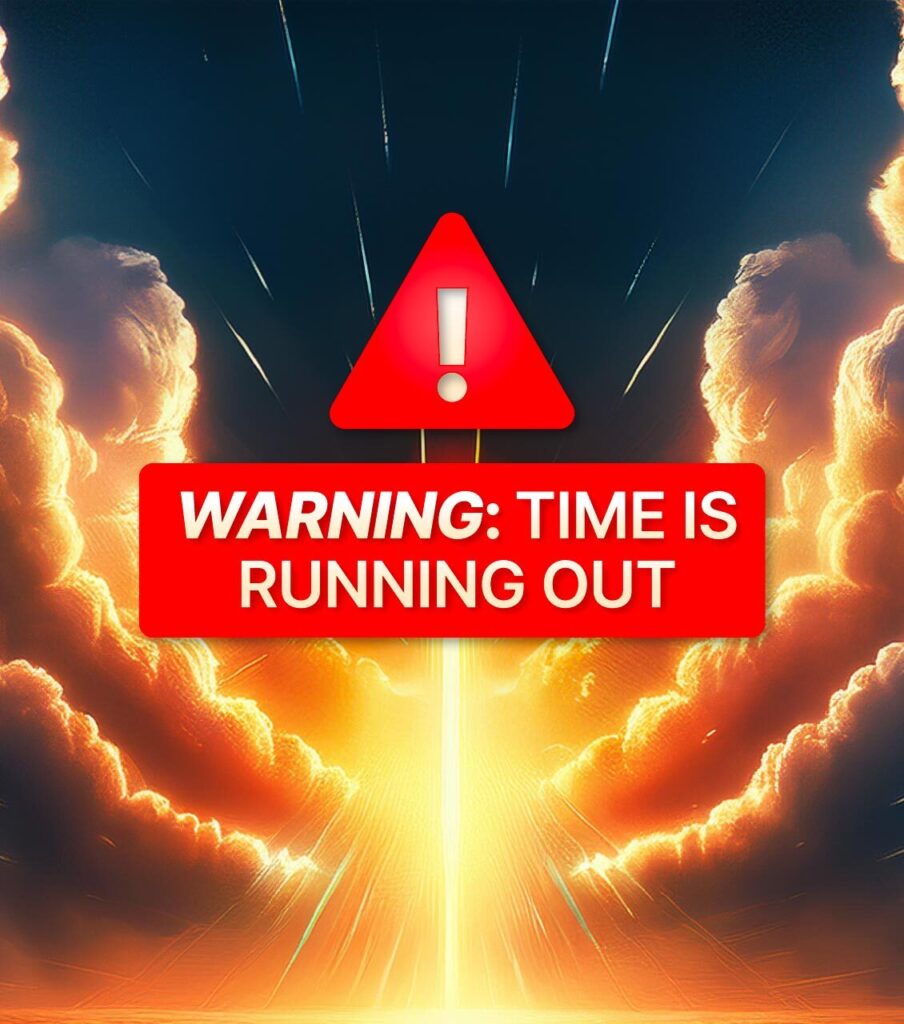Issue #39, Volume #2


Whether From Tariffs Or Something Else, Stocks Were Due To Fall
Will Trump’s Tariffs Push The World Into A New Depression?
This is Porter’s Daily Journal, a free e-letter from Porter & Co. that provides unfiltered insights on markets, the economy, and life to help readers become better investors. It includes weekday editions and two weekend editions… and is free to all subscribers.
| These are the days I live for… The Volatility Index jumped above 40… Trump’s tariff policy is absolute madness… Is it time to start buying?… 10-year Treasury yield moves below 4%… |
You know when you’ll never hear from your broker or your asset manager?
On a day when the CBOE Volatility Index (VIX) is trading above 30 and stocks are crashing!
But you will hear from me, because these are the days I live for! This is when great values emerge.
As you probably know, the VIX is an index that tracks the value of put options on the S&P 500. When it trades above 30, that’s an indication that investors are paying way too much for put options because they’re afraid the market is going to collapse.
Back in March, I told you to watch for the VIX trading above 30 – and to look to buy great businesses when it did. I’ve got an update to that advice, but first, let me answer the obvious question: How did I know stocks were about to tank?
Because the stock market was, until a few weeks ago, trading at the highest prices (measured against earnings) that we’d ever seen before in history. More expensive than 1929. More expensive than 2000. In fact, you had to go all the way back to 1844 (during the first railroad boom) to find a time in American history where stocks were this expensive.
While it’s true that most of this overvaluation has been centered on the Magnificent 7 – the giant tech companies – there are plenty of stocks trading at levels that don’t make any sense.
Just one quick example – McDonald’s (MCD) is trading at 27x earnings. It’s a great business and I’d love to own it, but buying at the current price just doesn’t make much sense. Using Ben Graham’s measure of intrinsic value (8.5 + earnings growth rate %) * (earnings per share) gives you a share price of (8.5 + 5.6) * (12.3) = $173. McDonald’s is trading today at over $300 per share, or nearly twice intrinsic value.
What I’ve seen in my own 30+ years of investing and what I know from financial history has taught me that bubbles seek out pins. Lots of people are going to blame President Trump for this decline in share prices, but such declines were inevitable. Stock prices have been wildly, historically, inflated. They were bound to correct.
Now… about Trump’s tariffs.
When I warned about the likelihood of stocks falling (and the VIX spiking) Trump had not yet revealed his tariffs. I don’t know anyone who thought Trump would unleash tariffs based on the size of each country’s trade surplus with the U.S. Nothing like this has ever been done before… and it is absolute madness. This is the largest tax increase in history, ever.
If these tariffs remain in place, the impact on the world’s economy will be catastrophic. We will see much lower corporate earnings, a global depression, and political fireworks – including dozens of revolutions – all around the world. The merits of these policies can be debated endlessly, but one thing is certain: Trump wants to end the “financialization” of the U.S. economy. He wants to stop the cycle of ever-larger government debt financed by foreign trade surpluses being re-invested in U.S. Treasuries. He believes, rightly, that America’s middle class is being destroyed because of never-ending inflation, that’s also driving asset prices higher and higher.
And he believes the way to solve this problem is with trade barriers.
Is this working? Yep. Let’s follow the rich versus poor indicator: shares of Ferrari (RACE) versus shares of Dollar General (DG).
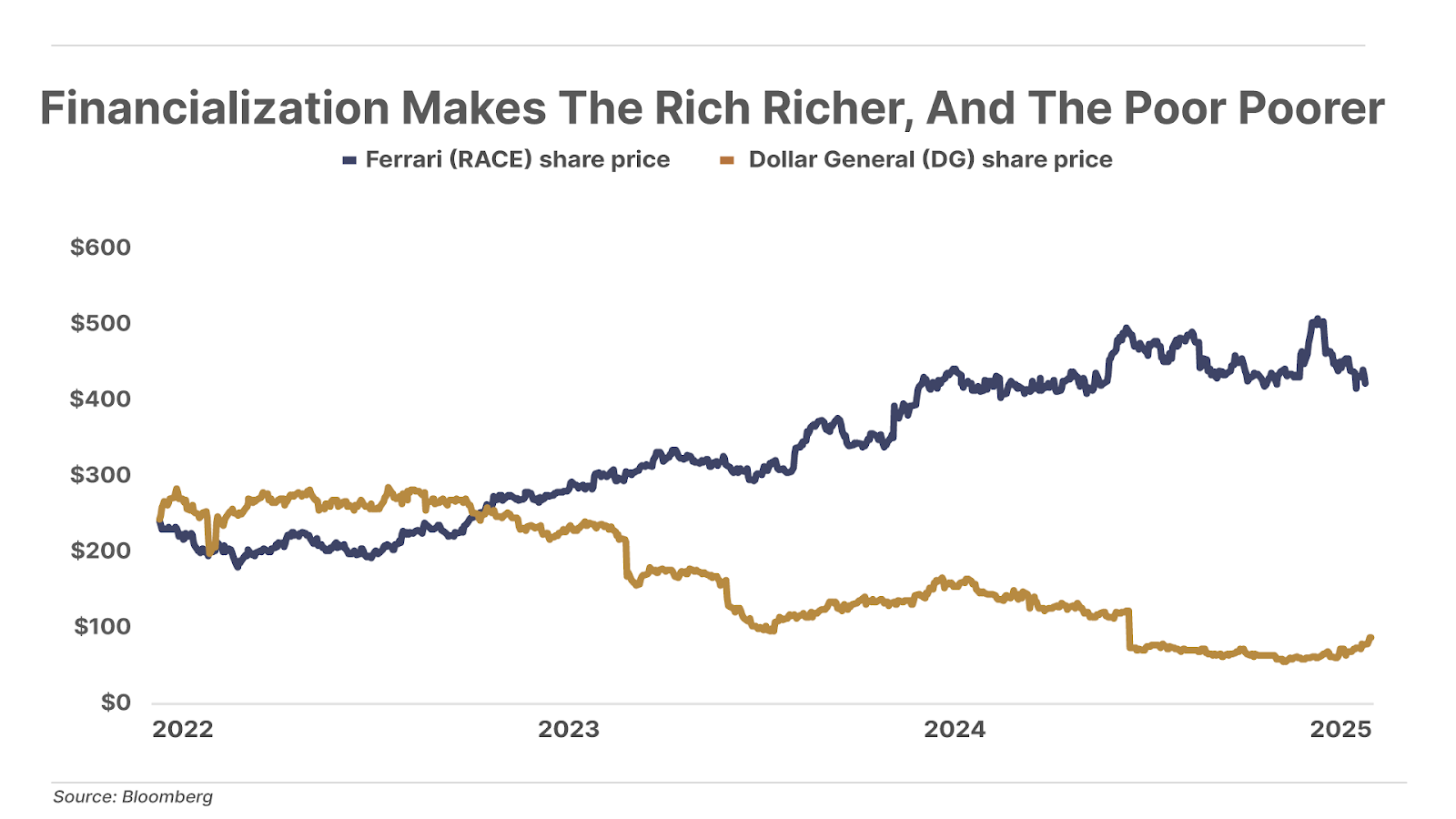

But is this actually a good idea? Can you increase the standard of living for most Americans by destroying thousands of businesses and impoverishing millions of people around the world? I doubt it.
There are plenty of countries that must run a trade surplus with the U.S. because they can’t afford to buy American products. And unless you want to see America’s standard of living decline to the level of Vietnam’s, then it’s not a good idea to try and force the return of textile manufacturing to the U.S.. A punitive tariff against Vietnam is nonsensical.
Likewise, I would be far more sympathetic to the president’s plan if it had been publicly announced, vetted by experienced economists, and if the world was given time to negotiate or adjust. Suddenly announcing that supply chains that were built over the last 40 years are immediately subject to extremely high tariffs is a recipe for a financial disaster.
And then there’s this: destroying the world’s economy won’t make any difference to American taxpayers unless the government actually cuts spending.
These tariffs will cause a global recession or maybe a global depression. That will decrease income tax revenue, which means, on a net basis, these tariffs will not increase government revenue. Without massive cuts to spending (which will never, ever happen) all these tariffs will do is yield yet more control over the private sector to the government.
That’s not good news for anyone.
The risk now is that the longer this goes on, the more people get wiped out: in margin accounts, in speculative stocks, or because they can’t emotionally handle the volatility and sell to end the anxiety.
As Warren Buffett points out, most people do dumb things when they invest in stocks.
I want to encourage you to do smart things, not dumb things.
The time to sell stocks was six weeks ago when the market rallied to prices that were impossible to sustain. I made this video at the time, warning everyone.
And we also took an extraordinary step: we recommended selling two stocks – Bank of America (BAC) and Boeing (BA) – short as a hedge against what we believed was the most overvalued stock market of all time. Both of those “hedges” are now up more than 20%.
Our portfolio has also been buoyed this year because of our generally conservative investment strategy that’s focused on ultra-high-quality businesses, property and casualty (P&C) insurance, and great energy companies.
If you bought all of our recommendations at the start of this year, you’re up significantly on: our best P&C firms (WR Berkley +18%, Progressive +14%), our top consumer brand companies (Philip Morris +31%, Celsius Holdings +34%), and our legendary gold royalty firm (Franco-Nevada +27%). You’ve also seen substantial declines in U.S. energy export companies (Peabody Energy -49%, Core Natural Resources -44%, Venture Global -29%, CNX Resources -21%). We’ve also seen big declines this year in tech stocks (PayPal -31%) and Nike (-29%), which depends on Vietnam to produce many of its shoes.
Overall, since January 1, our portfolio, on average, is down 5.8%. That’s roughly half of the market’s overall decline (S&P 500 is down 11.3%).
And, if you adopted our Permanent Portfolio strategy as I recommended last fall, you’re up about 6.6% year to date, and you’ve got 25% of your portfolio in cash, much like Warren Buffett!
Is it time to start buying?
I told you last week that buying when the VIX closes above 30 has historically led to very good results. And for certain businesses that are down 80% or more (like Rémy Cointreau, which I wrote about on Wednesday), I think you’ll be fine. But this global trade war isn’t like a regular market correction. If these tariffs and retaliatory tariffs remain in place, the global economy will be destroyed. In that outcome, I believe stocks have much, much further to fall.
Also, I would encourage you to look beyond stocks right now.
I recently explained why for my “second life” I’ve decided to focus my personal investing into high-yield corporate bonds. I suspect that the equity markets are going to be volatile for a long time, as valuations still must come down another 50% in most large-cap tech stocks. I’ve also been watching Distressed Investing editor Marty Fridson over the years – he’s able to generate 20%+ annual returns with much, much less risk than investing in stocks. Now that I’m over 50, I’m more focused than ever before on avoiding risk.
Thus, I’m not only watching the VIX these days, I’m also watching the Bank of America U.S. High Yield Index Option-Adjusted Spread.
This index shows how much higher the yields are on non-investment-grade corporate bonds than similar duration U.S. Treasury bonds. This so-called “risk premium” can spike during periods of fear in the bond markets. Thus, this index is the “fear gauge” in the bond market, much like the VIX is in the stock market.
I’m looking for the “risk premium” to reach at least 5% and, ideally, to more than 7.5%.
Yesterday the index closed at 4.01%, up from a recent low of 2.6%. It’s during these spikes in corporate bond yields where you can set up investments that will pay you cash yields in excess of 10% annually with total returns over three to four years of more than 15% annually.
So, my current advice is: remain patient and consistent. Don’t sell great businesses merely because they’re having a bad quarter. And never sell just because other people are foolishly dumping great assets at fire-sale prices.
Wait for great values to emerge.
They will.
“You’ll be jealous of others if you miss this…”
Elon Musk’s next venture is about to explode and you have the chance to get exposure before it goes public.
It’s as simple as using a free 4-letter ticker symbol to get pre-IPO exposure.
Don’t standby as everyone grows wealthier from Elon yet again…
Three Things To Know Before We Go…
1. Trade war escalates market panic. In response to President Donald Trump’s tariff announcement Wednesday, China imposed a 34% across-the-board tariff on imports from the U.S., while also adding 11 American corporations to its “unreliable entities” list that will effectively ban these companies from doing business in China. The news sent financial markets plunging, with losses in the U.S. led by the tech-heavy Nasdaq Composite Index dropping by 5%, following a 5% decline on Thursday. With the CBOE Volatility Index (VIX) surging above 40, bargains are starting to emerge, although the risk of further downside remains.
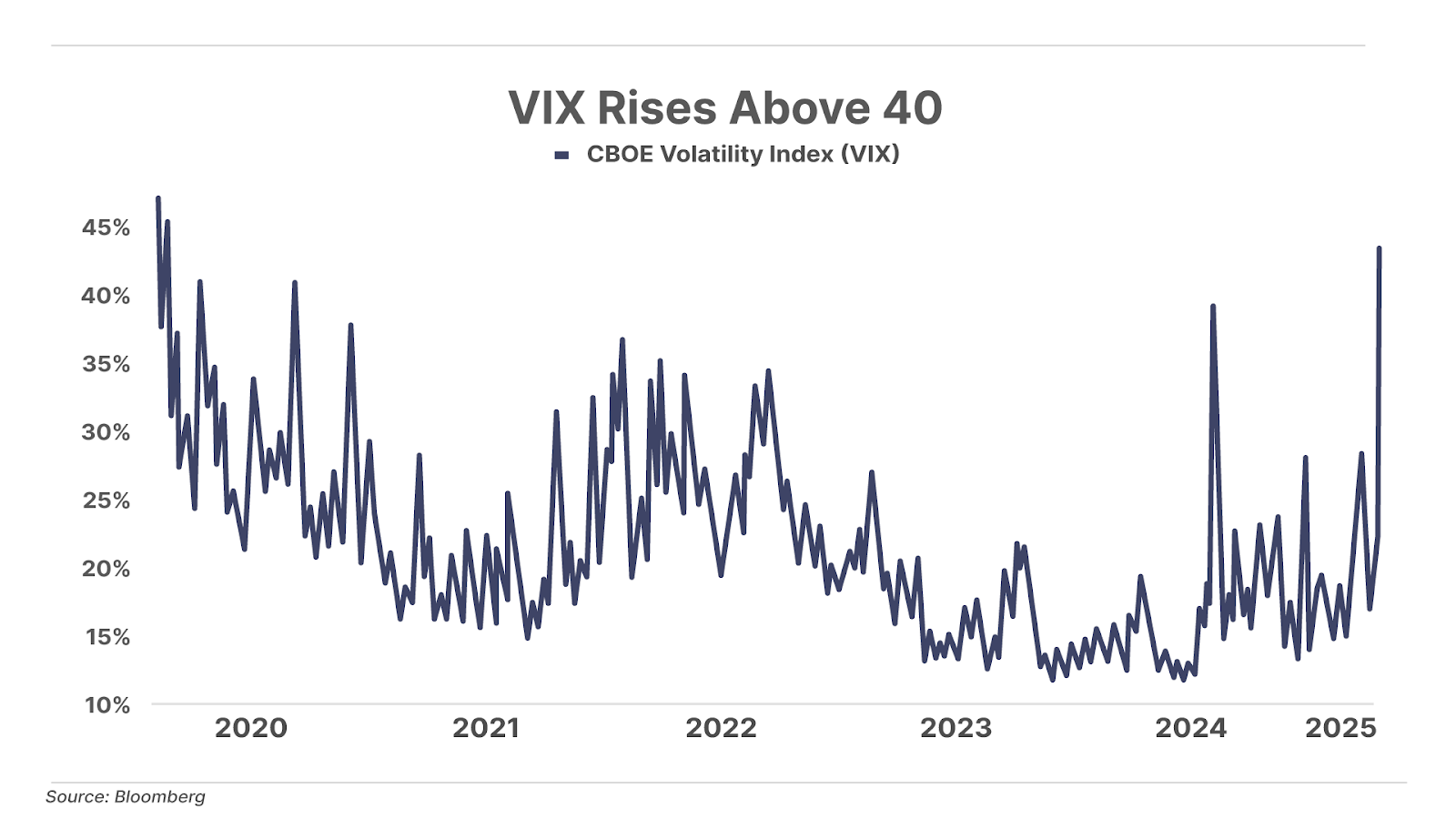
2. Long-term rates are falling. This morning, the 10-year U.S. Treasury yield fell below 4% for the first time since last October. U.S. President Donald Trump and Treasury Secretary Scott Bessent have said bringing down long rates is a key objective this year, to lower mortgage rates and the cost of consumer debt – both of which are tied to 10-year yields – and to help the government refinance the roughly $9 trillion in Treasury debt scheduled to come due over the next 12 months.
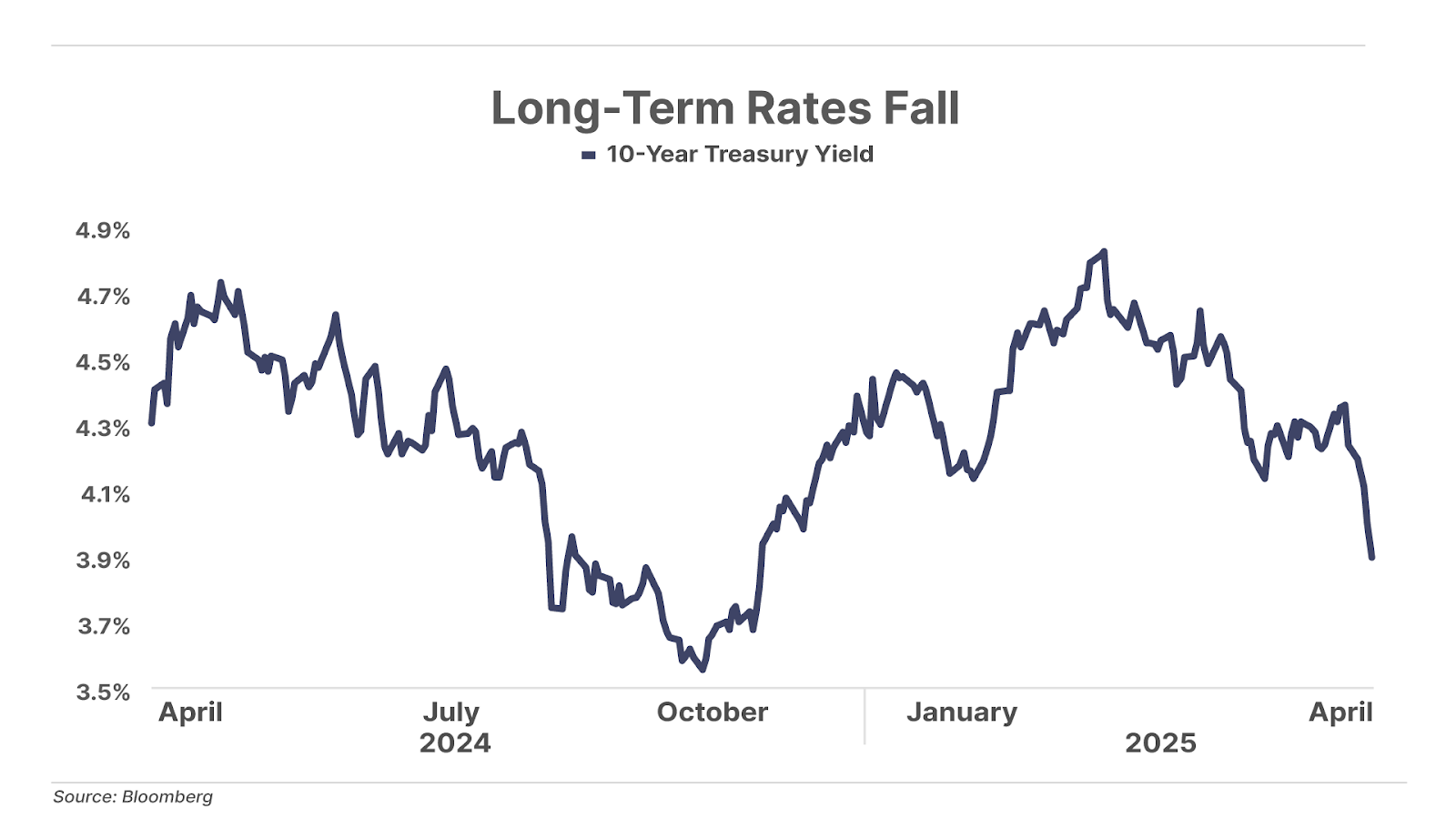
3. A frothy jobs report shields cracks in the economy. The U.S. economy added 228,000 jobs in March – blowing past the consensus estimate of 140,000, for the strongest gain of the year. However, signs of underlying weakness are piling up. February’s jobs number was revised down to just 116,000 from the previously reported 140,000, and the Challenger Job Cuts report released yesterday showed that U.S. companies slashed 257,240 jobs in March – the biggest bump in layoffs since the pandemic. Meanwhile, the unemployment rate jumped to 4.2% in March, suggesting real weakness beneath the surface. If a recession hits, this could unravel fast.
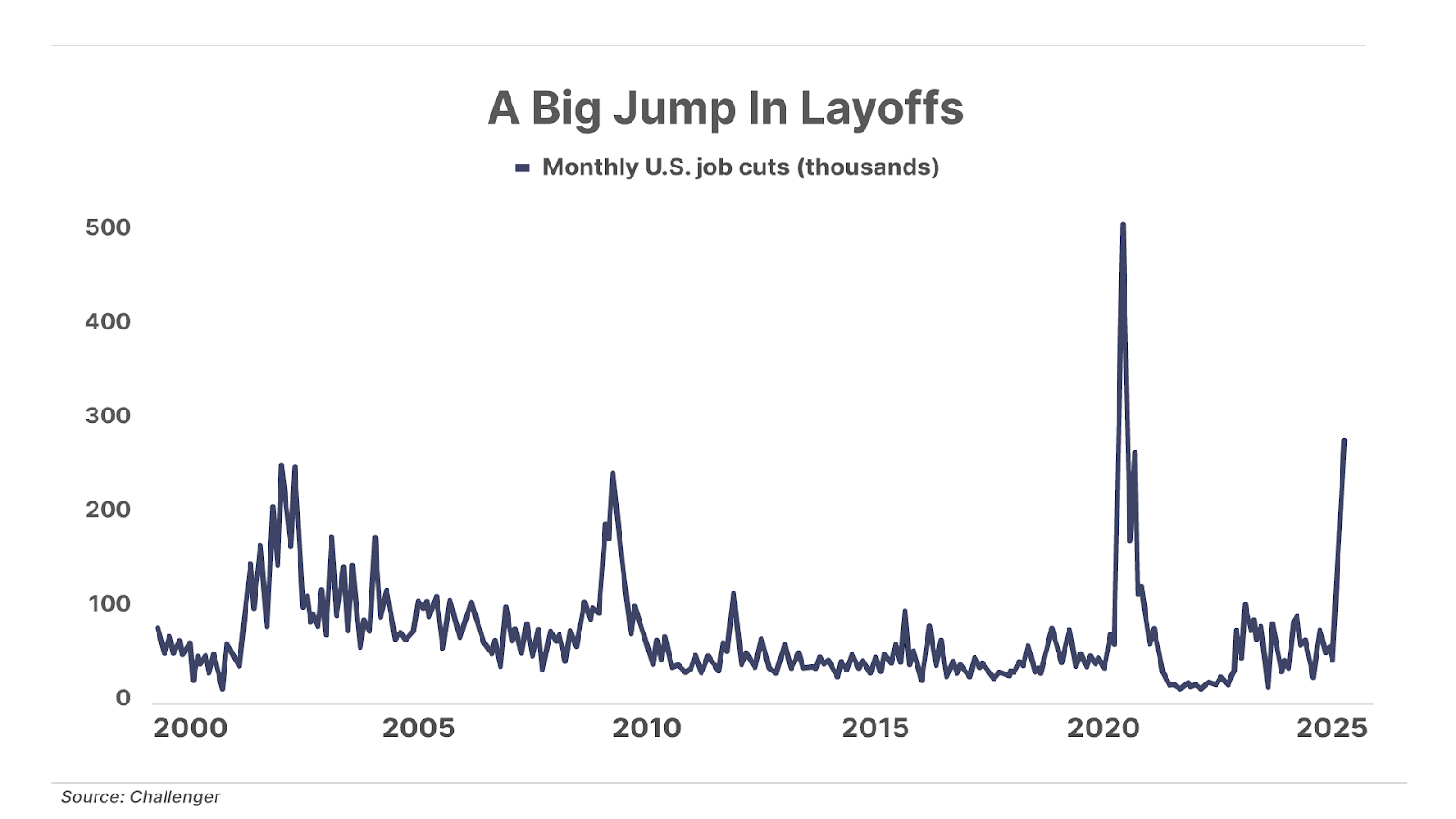
And one more thing… Tariffs take their toll
The huge serving of tariffs Trump announced on Wednesday exceeded even the most bearish forecasts, leading to a $2.5 trillion collapse in the U.S. stock market. China’s retaliation with reciprocal tariffs this morning sparked another bloody day in global financial markets. Investors who followed our warnings about the growing risks of a trade war, along with the risks of the inflated valuations in U.S. stocks, should be in a healthy position with plenty of cash and defensive assets like gold. We’re starting to see bargains emerge, including names like Nike (NKE), which was hit particularly hard on the tariff fears. We expect more opportunities ahead as the wealth wipeout from the collapsing stock market eventually filters into the real economy.
And… if you followed Porter’s previous advice (from the March 5 Daily Journal) to raise cash and prepare for a panic, and are now wondering what to buy with that cash, we’re publishing our latest list of the world’s greatest businesses trading at discounted valuations in the Saturday Screen, in tomorrow’s Daily Journal. Check your inbox at 10 am ET.
As always, let me know what you think: [email protected]
Mailbag
Thanks for the writeup on Rémy Cointreau in Wednesday’s Daily Journal. What an incredible business! This will be a great one for the children’s portfolios.
I am a horse meeting water.
Matt V.”
Appreciate reading about tobacco and liquor companies, but both of these run counter to my personal principles regarding companies that profit from abusive-addictive products. Suggestions on great companies that don’t benefit from these types of products?
Don L.”
Porter’s comment: Don – Have you seen our recommended portfolio? Out of 50-odd recommendations, I think you’d morally object to three of them.
Good investing,
Porter Stansberry
Stevenson, MD
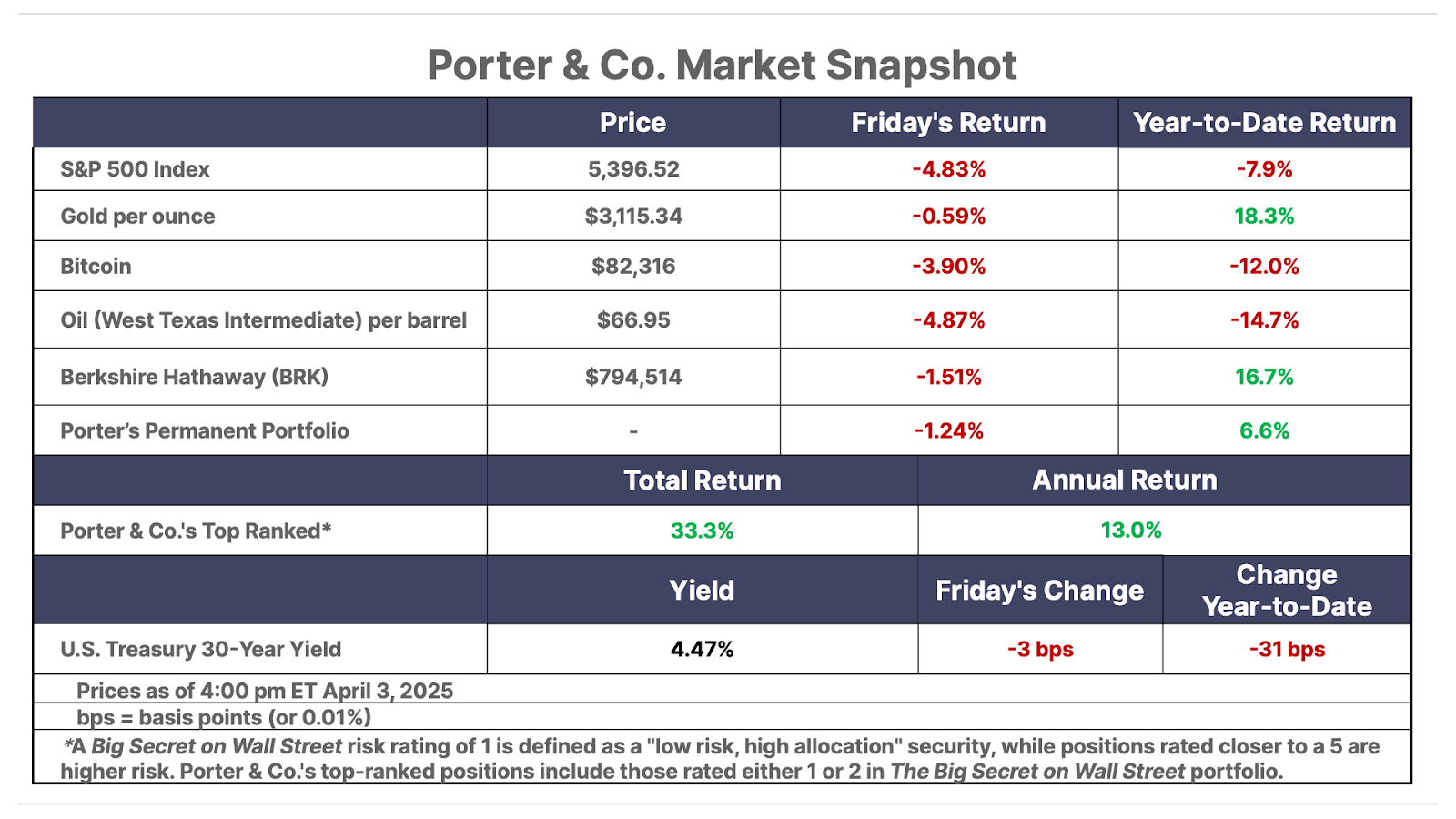
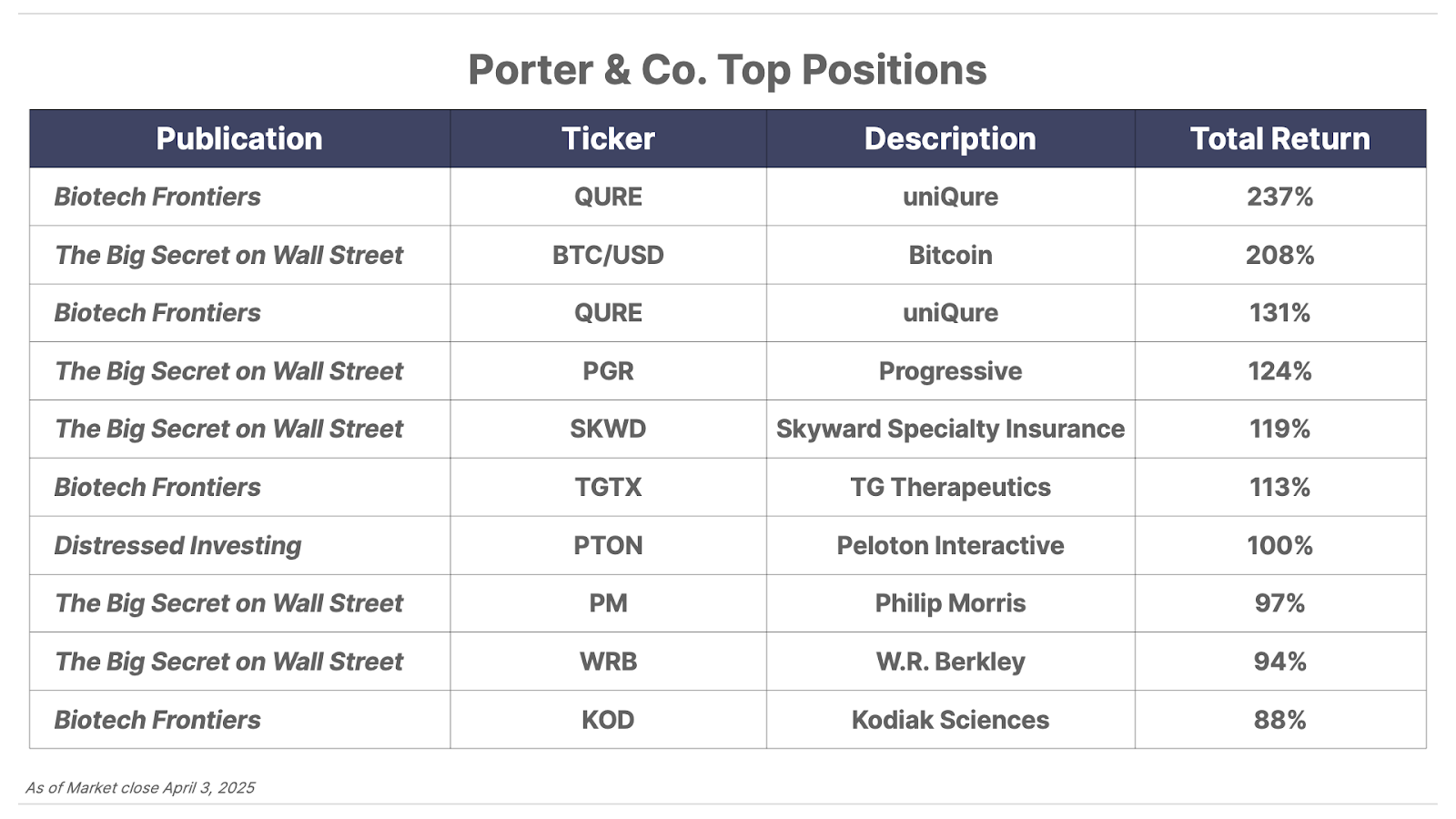
Please note: The investments in our “Porter & Co. Top Positions” should not be considered current recommendations. These positions are the best performers across our publications – and the securities listed may (or may not) be above the current buy-up-to price. To learn more, visit the current portfolio page of the relevant service, here. To gain access or to learn more about our current portfolios, call Lance James, our Director of Customer Care, at 888-610-8895 or internationally at +1 443-815-4447.
